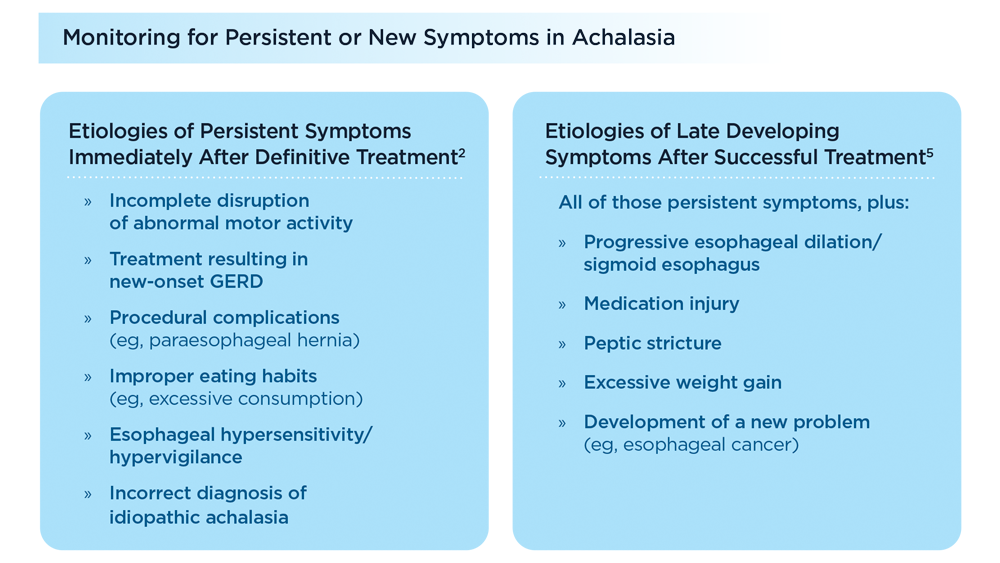User login
Achalasia Remains a Challenging Disorder for the Community Gastroenterologist
Click to view more from Gastroenterology Data Trends 2022.
Achalasia articles using keywords esophageal achalasia or cardiospasm or achalasia in PubMed: https://pubmed.ncbi.nlm.nih.gov/?term=esophageal+achalasia+or+cardiospasm+or+achalasia&filter=years.2002-2022&timeline=expanded
Patel DA, Yadlapati R, Vaezi MF. esophageal motility disorders: current approach to diagnostics and therapeutics. Gastroenterology. 2022;162(6):1617-1634. doi:10.1053/j.gastro.2021.12.289
Delshad SD, Almario CV, Chey WD, Spiegel BMR. Prevalence of gastroesophageal reflux disease and proton pump inhibitor-refractory symptoms. Gastroenterology. 2020;158(5):1250-1261.e2. doi:10.1053/j.gastro.2019.12.014
van Hoeij FB, Ponds FA, Smout AJ, Bredenoord AJ. Incidence and costs of achalasia in The Netherlands. Neurogastroenterol Motil. 2018;30(2):e13195. doi:10.1111/nmo.13195
Khan A, Yadlapati R, Gonlachanvit S, et al. Chicago Classification update (version 4.0): technical review on diagnostic criteria for achalasia. Neurogastroenterol Motil. 2021;33(7):e14182. doi:10.1111/nmo.14182
Gaddam S, Reddy CA, Munigala, et al. The learning curve for interpretation of oesophageal high-resolution manometry: a prospective interventional cohort study. Aliment Pharmacol Ther. 2017;45(2):291-299. doi:10.1111/apt.13855
Yadlapati R, Keswani RN, Ciolino JD, et al. A system to assess the competency for interpretation of esophageal manometry identifies variation in learning curves. Clin Gastroenterol Hepatol. 2017;15(11):1708-1714.e3. doi:10.1016/j.cgh.2016.07.024
Saboori S, Jarvis M, Baker J, et al. Hard to swallow results. Dysphagia. 2022;37(4):863-867. doi:10.1007/s00455-021-10344-x
Babaei A, Szabo A, Shad S, Massey BT. Chronic daily opioid exposure is associated with dysphagia, esophageal outflow obstruction, and disordered peristalsis. Neurogastroenterol Motil. 2019;31(7):e13601. doi:10.1111/nmo.13601
Babaei A, Shad S, Massey BT. Motility patterns following esophageal pharmacologic provocation with amyl nitrite or cholecystokinin during high-resolution manometry distinguish idiopathic vs opioid-induced type 3 achalasia. Clin Gastroenterol Hepatol. 2020;18(4):813-821.e1. doi:10.1016/j.cgh.2019.08.014
Babaei A, Shad S, Massey BT. Diagnostic differences in the pharmacologic response to cholecystokinin and amyl nitrite in patients with absent contractility vs type I achalasia. Neurogastroenterol Motil. 2020;32(8):e13857. doi:10.1111/nmo.13857
Click to view more from Gastroenterology Data Trends 2022.
Click to view more from Gastroenterology Data Trends 2022.
Achalasia articles using keywords esophageal achalasia or cardiospasm or achalasia in PubMed: https://pubmed.ncbi.nlm.nih.gov/?term=esophageal+achalasia+or+cardiospasm+or+achalasia&filter=years.2002-2022&timeline=expanded
Patel DA, Yadlapati R, Vaezi MF. esophageal motility disorders: current approach to diagnostics and therapeutics. Gastroenterology. 2022;162(6):1617-1634. doi:10.1053/j.gastro.2021.12.289
Delshad SD, Almario CV, Chey WD, Spiegel BMR. Prevalence of gastroesophageal reflux disease and proton pump inhibitor-refractory symptoms. Gastroenterology. 2020;158(5):1250-1261.e2. doi:10.1053/j.gastro.2019.12.014
van Hoeij FB, Ponds FA, Smout AJ, Bredenoord AJ. Incidence and costs of achalasia in The Netherlands. Neurogastroenterol Motil. 2018;30(2):e13195. doi:10.1111/nmo.13195
Khan A, Yadlapati R, Gonlachanvit S, et al. Chicago Classification update (version 4.0): technical review on diagnostic criteria for achalasia. Neurogastroenterol Motil. 2021;33(7):e14182. doi:10.1111/nmo.14182
Gaddam S, Reddy CA, Munigala, et al. The learning curve for interpretation of oesophageal high-resolution manometry: a prospective interventional cohort study. Aliment Pharmacol Ther. 2017;45(2):291-299. doi:10.1111/apt.13855
Yadlapati R, Keswani RN, Ciolino JD, et al. A system to assess the competency for interpretation of esophageal manometry identifies variation in learning curves. Clin Gastroenterol Hepatol. 2017;15(11):1708-1714.e3. doi:10.1016/j.cgh.2016.07.024
Saboori S, Jarvis M, Baker J, et al. Hard to swallow results. Dysphagia. 2022;37(4):863-867. doi:10.1007/s00455-021-10344-x
Babaei A, Szabo A, Shad S, Massey BT. Chronic daily opioid exposure is associated with dysphagia, esophageal outflow obstruction, and disordered peristalsis. Neurogastroenterol Motil. 2019;31(7):e13601. doi:10.1111/nmo.13601
Babaei A, Shad S, Massey BT. Motility patterns following esophageal pharmacologic provocation with amyl nitrite or cholecystokinin during high-resolution manometry distinguish idiopathic vs opioid-induced type 3 achalasia. Clin Gastroenterol Hepatol. 2020;18(4):813-821.e1. doi:10.1016/j.cgh.2019.08.014
Babaei A, Shad S, Massey BT. Diagnostic differences in the pharmacologic response to cholecystokinin and amyl nitrite in patients with absent contractility vs type I achalasia. Neurogastroenterol Motil. 2020;32(8):e13857. doi:10.1111/nmo.13857
Achalasia articles using keywords esophageal achalasia or cardiospasm or achalasia in PubMed: https://pubmed.ncbi.nlm.nih.gov/?term=esophageal+achalasia+or+cardiospasm+or+achalasia&filter=years.2002-2022&timeline=expanded
Patel DA, Yadlapati R, Vaezi MF. esophageal motility disorders: current approach to diagnostics and therapeutics. Gastroenterology. 2022;162(6):1617-1634. doi:10.1053/j.gastro.2021.12.289
Delshad SD, Almario CV, Chey WD, Spiegel BMR. Prevalence of gastroesophageal reflux disease and proton pump inhibitor-refractory symptoms. Gastroenterology. 2020;158(5):1250-1261.e2. doi:10.1053/j.gastro.2019.12.014
van Hoeij FB, Ponds FA, Smout AJ, Bredenoord AJ. Incidence and costs of achalasia in The Netherlands. Neurogastroenterol Motil. 2018;30(2):e13195. doi:10.1111/nmo.13195
Khan A, Yadlapati R, Gonlachanvit S, et al. Chicago Classification update (version 4.0): technical review on diagnostic criteria for achalasia. Neurogastroenterol Motil. 2021;33(7):e14182. doi:10.1111/nmo.14182
Gaddam S, Reddy CA, Munigala, et al. The learning curve for interpretation of oesophageal high-resolution manometry: a prospective interventional cohort study. Aliment Pharmacol Ther. 2017;45(2):291-299. doi:10.1111/apt.13855
Yadlapati R, Keswani RN, Ciolino JD, et al. A system to assess the competency for interpretation of esophageal manometry identifies variation in learning curves. Clin Gastroenterol Hepatol. 2017;15(11):1708-1714.e3. doi:10.1016/j.cgh.2016.07.024
Saboori S, Jarvis M, Baker J, et al. Hard to swallow results. Dysphagia. 2022;37(4):863-867. doi:10.1007/s00455-021-10344-x
Babaei A, Szabo A, Shad S, Massey BT. Chronic daily opioid exposure is associated with dysphagia, esophageal outflow obstruction, and disordered peristalsis. Neurogastroenterol Motil. 2019;31(7):e13601. doi:10.1111/nmo.13601
Babaei A, Shad S, Massey BT. Motility patterns following esophageal pharmacologic provocation with amyl nitrite or cholecystokinin during high-resolution manometry distinguish idiopathic vs opioid-induced type 3 achalasia. Clin Gastroenterol Hepatol. 2020;18(4):813-821.e1. doi:10.1016/j.cgh.2019.08.014
Babaei A, Shad S, Massey BT. Diagnostic differences in the pharmacologic response to cholecystokinin and amyl nitrite in patients with absent contractility vs type I achalasia. Neurogastroenterol Motil. 2020;32(8):e13857. doi:10.1111/nmo.13857

